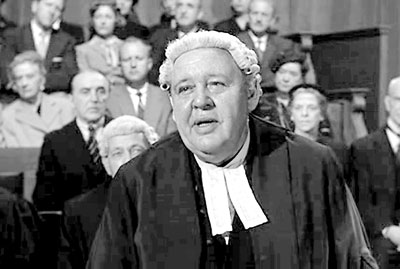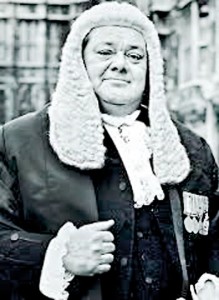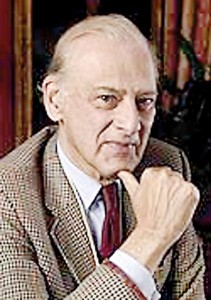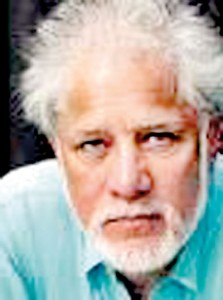Sunday Times 2
Witness for the prosecution
When the witness for the prosecution takes his or her place in the courtroom, everyone sits up very straight or leans forward, straining to hear every last word in the key testimony. The person who leans forward the most is the presiding judge. The accused, meanwhile, tries not to look overly interested; an unruffled, inscrutable expression suits the person in the dock. The witness for the prosecution is the bearer of bad news on which the fate of the accused hangs. In a murder trial, when the witness for the prosecution speaks, the atmosphere is hyper-tense — taut as a mousetrap, brittle as an old-fashioned glass thermometer.
When servant boy Hewa Marambage William was made crown witness for the prosecution in the famous trial in which the cricket wizard Mahadeva Sathasivam stood charged for the murder of his wife Ananda Sathasivam, the whole country sat up and listened.

British actor Charles Laughton, left, in the Agatha Christie courtroom thriller "Witness for the Prosecution
The country heard that on October 9, 1951, Mahadeva Sathasivam, the master of the house at No. 7 St. Alban’s Place, Bambalapitiya, had compelled Hewa Marambage William, the recently employed domestic helper, to assist in the murder of Ms. Sathasivam. The servant boy’s testimony was subjected to furious scrutiny by some of the country’s best legal and medical minds, including that of a foreign forensic expert of world repute. After a 57-day trial that the whole country was following, Mahadeva Sathasivam, the accused, was found not guilty.
Those who stood up to see the exonerated Mr. Sathasivam leave court a free man would have then turned towards the crown witness for the prosecution, the now 21-year-old servant boy from Matara who was pardoned on condition he gave a truthful account of what happened at the Sathasivam residence on the morning of the murder. The not-guilty verdict for Mr. Sathasivam automatically slapped a guilty verdict on the servant boy. The boy’s statement as crown witness would be denounced as a hideous falsehood.
The servant boy’s testimony has been pored over by members of the legal and medical profession and the public for 63 years. You can accept the servant boy’s story as fact or fiction. The official verdict makes the servant boy a liar and a murderer, but the unofficial, private verdict of a surprising many who have studied the case and spent years mulling over it is that the servant boy’s story is essentially true.
Witness for the prosecution — exciting words that promise shocks and revelations. We believe we first heard this arresting, sibilant sequence of courtroom words in a cinema context. It would have been around 1960, even earlier.
Older Brother as a teen was a great filmgoer, and we remember his returning from a matinee one evening full of a movie that was not about World War II or Cowboys and Indians. It was a sober, civilised British courtroom drama called “Witness for the Prosecution”, and it had left a strong impression on Older Brother.

Justice Noel Gratiaen
The bell rang a couple of years later, when we had begun our shadowy career in crime fiction consumption. “Witness for the Prosecution” was a 1953 Agatha Christie stage play that was made into a brilliant film in 1957 by the great German-American movie director Billy Wilder. We wouldn’t see the film till years later, when we had started to collect movie classics. As a schoolboy we had read the play, along with a string of other Christie plays. These were all available, in their slim, blue-and-white-covered Samuel French acting editions, at the old seaside British Council library, at Steuart Lodge, Kollupitiya.
Having worked our way through all the Christie stage thrillers, we paused over a play that was not a Christie but could well have been. It was a comedy thriller with a playful title, “Murder isn’t Cricket”, written by an obscure British playwright. So very English.
A thing that “isn’t cricket” is unacceptable, simply “not done.” The online Oxford Dictionary defines “not cricket” as “something contrary to traditional standards of fairness or rectitude.” The Oxford provides an example of usage: “An appeal by the Crown against too lenient a sentence is simply not cricket.”
The black-and-white Billy Wilder classic kept cutting into our reading of Prof. Ravindra Fernando’s “A Murder in Ceylon,” the forensic specialist’s book on the famous Sathasivam case. Each time the words “witness for the prosecution” popped up in the text, so too did courtroom images from the film.
There was also another reason the Billy Wilder film kept flashing images at us as we read through “A Murder in Ceylon”: the face of Noel Gratiaen, the presiding judge in the Sathasivam case, kept merging with that of Charles Laughton, the

The Sathasivam Case is mentioned in books by Justice Noel Gratiaen's nephews Sir Christopher Ondaatje
English actor who so brilliantly played the part of the barrister Sir Wilfrid Robarts in the Agatha Christie drama, which was about a man charged with murder. In their judge and barrister wigs, Noel Gratiaen and Charles Laughton belonged together; both men had full, pudgy faces, seemed of similar age, and were cut from the same cloth. The Hulftsdorp Supreme Court setting of “A Murder in Ceylon” kept shuffling places with the wood-panelled Old Bailey courtroom film set. Art was intercutting with Life; Fiction and Make-Believe were exchanging nods with Reality and History.
Justice Noel Gratiaen’s fluid and eloquent address to the jury, with its drama and suspense, buildups and climaxes, has, one might say, a bookish, literary flavour.
The literary note carries over into two books by Noel Gratiaen’s writer nephews, Sir Christopher and Michael Ondaatje. Mahadeva Sathasivam was a cricket hero to the two youthful Ondaatjes and all their friends and contemporaries. The Sathasivam case is alluded to in Michael Ondaatje’s recent novel, “The Cat’s Table”, a first-person narrative by a half-real, half-fictional Ceylonese schoolboy. The narrator informs school friends that a famous cricketer being tried in Colombo for murder is innocent; the friends

Michael Ondaatje
want to know how he knows, and the narrator says his uncle, the presiding judge, said so. The mind of the judge in the book is made up about the innocence of the accused in a trial in progress.
In his essay collection “The Last Colonial”, Sir Christopher Ondaatje devotes a chapter to Prof. Ravindra Fernando’s book. The author recalls his last meeting with his uncle, the judge, in London at the end of the Sixties. The Sathasivam case entered the conversation. The Attorney-General’s Department made a big mistake in pardoning the servant boy, said Noel Gratiaen. “It was irreversible. . . . There is little doubt that Sathasivam was innocent. He was a scoundrel, but not a murderer.”
A nightmare-fantasy drawing illustrates Sir Christopher’s essay-review; a leering, evil-looking, incubus-like creature, in a sarong and naked from the waist up, bends over the body of a sleeping or dead woman. The guilt of the servant boy in the case is assumed and given grotesque form.
The early hours
The early hours are good for a clear head. During the day you have been reading and thinking about something, and this something continues to murmur and mutter away even when you aren’t consciously thinking about it. Sometimes details don’t quite add up and start to niggle at a subliminal level. You go to bed and fall asleep only to sit up two hours later with flutters of lightning inside your skull. Some nights the lightning is real, outside your skull, outside the room. Thunder, lightning, rain. You think “Macbeth.” Three hags. The room is cold. Turn off the fan. Like black witches capes, queries flap for attention. An oddly shaped jigsaw piece isn’t fitting.
For a week, after a first reading of Prof. Ravindra Fernando’s book, we would wake up around two in the morning to ask no one in particular Sathasivam trial-related questions.
One question had to do with the forensic experts’ calculations to ascertain Ananda Sathasivam’s time of death. That was a deciding factor. The case seesawed on the fact of 10.30 am, the time Mahadeva Sathasivam said he left the house, with Ms. Sathasivam remaining at home, alive and in good health.
The three main considerations were the falling rate of body heat, rigor mortis, and the status of solid and liquid content in the dead person’s digestive tract. Body heat loss is considered the most reliable indicator of the three. Forensic expert Prof. G. S. W. de Saram took into consideration the victim’s body temperature at the time he examined it (it was 93.2 degrees Fahrenheit, at 6.55 pm), the general atmospheric temperature that day, and the air temperature inside the closed garage where the body was found.
But what about the cold cement floor? How come that wasn’t brought up?
We are talking about the concrete surface on which Ananda Sathasivam’s body had been lying for up to seven or eight hours. Shouldn’t that have counted for something? How come the garage floor temperature was not factored into the forensic specialist’s calculations for body cooling rate?
The professor had thought of everything. Along with the rate a body starts to cool after death, he considered body weight, clothing on the body, ambient temperature (air temperature outside and inside the house), and comparable body temperatures of executed prisoners, but nothing to indicate he had considered the garage floor temperature.
Mobile phone messages about the relevance of the garage floor temperature are sent out at 3 am to half a dozen persons who can be depended on for an educated reply: Wouldn’t the body lose heat to the floor, and absorb some of the coolness within the floor?
Replies come in later in the morning to confirm the query’s relevance. Good friend and former Form 1 classmate Dr. Susirith Mendis, Senior Professor of Physiology, SMSes back to endorse the query. The former Vice-Chancellor, University of Ruhuna, and former Deputy Vice-Chancellor, General Sir John Kotelawala Defence University, adds:
“Furthermore, if the temperature of the cement floor is cooler than the ambient temperature, there could be an additional loss of heat from body to floor, through conduction, even though both the cement floor and the body are poor conductors of heat.”
The only reference to the garage floor came from Sir Sydney Smith, Prof. G. S. W. de Saram’s mentor, who mentioned the garage floor in a by-the-way listing of other factors that may have influenced the victim’s body temperature. As quoted in “A Murder in Ceylon,” Sir Sydney said the victim “weighed 90 pounds, was poorly nourished, clad only in a petticoat and saree, and part of her body was in contact with the concrete floor of the garage.”
The Government Analyst’s photograph of the scene of the crime shows the body of Ananda Sathasivam lying on its back, stretched out on the garage floor. Much of the surface of the back of the body would have been in contact with the concrete floor for all the hours the corpse had been left lying there and kept waiting until its removal late that evening.
If the cement floor temperature of the garage of No. 7 St. Alban’s Place on October 9, 1951 is relevant, as relevant as was the atmospheric reading of 81 degrees Fahrenheit recorded that day, then the professor’s conclusion that death occurred between 10 am and 11.15 am could be considered incomplete, inconclusive.
If the garage floor temperature is significant enough to merit being in the equation, why was it left out of the professor’s meticulous calculations?
And why did Prof. de Saram’s mentor, the world-famous forensic expert Sir Sydney Smith, not make more of the garage floor temperature as an influencing factor?
Establishing time of death was essential in determining the innocence or guilt of servant or master.
Drag mark on kitchen floor
Much was made at the trial of a wavy drag mark on the kitchen floor, near the narrow doorway opening into the garage. The mark was 1 ½ to 2 ½ inches wide and 18 inches long. It was not photographed as evidence because the police officer in charge did not think it was important, especially after dozens of police officers and others had tracked through the kitchen that day.
Sir Sydney gave his views on the drag mark, which the defence believed was caused by one of Ms. Sathasivam’s feet touching the floor as her body was being taken to the garage.
Now, if the body had been carried by two persons, it may be supposed that the person who was holding the body’s lower half let go of one leg, which dragged along the floor and left a trace. But if one person had transferred the body to the garage, as the defence made out, that single drag mark becomes a poser.
It was suggested that the wavy drag mark could have been caused by a human heel rubbing the floor. If so, where was the wavy mark that should have been left by the heel of the other foot? The only way you can drag a body across a grimy floor and leave a single wavy drag mark is to cross one dead foot over the other, leaving one foot clear of the floor. Awkward, granted, especially if you are in a hurry to dispose of a corpse.
Now picture a single person attempting to transport a dead body from point A to point B. There are many ways a single person can drag a body: 1.By holding the body’s upper half against your chest, facing away from you, while you walk backwards; that would result in both heels of the body dragging, and would leave not one but two parallel drag marks; 2. By dragging a body with its upper half against your chest, its head against your face; that would result in the tops of the bare feet and toes grazing the floor; 3. By dragging a body by its arms, or by one arm, in which case much of the body surface from the waist down would touch the floor and leave a swathe of a mark; 4. By dragging a body by the hair, face up or face down, in which case even more of the body surface and clothes would sweep the floor.
If the body is light enough, you acting alone can carry the body, one arm round the dead person’s shoulders, the other supporting the dangling legs from under the knee joints. If one leg of the dead person were to slip out from the carrying person’s grip, the loose leg could hang low enough to graze the floor. That was what Sir Sydney Smith suggested.
It was essential for the defence to establish that the murder took place in the kitchen and that it was entirely the work of the servant boy.
A big puzzler (big in size and big at generating conjecture) was found in the garage: the wood mortar that had been placed on the victim’s neck. What purpose did that serve? Even Justice Noel Gratiaen was at a loss to explain the mortar’s presence.
The mortar ceases to be a puzzle if you look at it not as a clue or an instrument of attack but as a prop at the crime scene. It was an artistic, theatrical touch, a heavy, cumbrous detail to reinforce the look of the murder as having been committed by someone confined to the narrow world of kitchen and pantry.
To be continued

